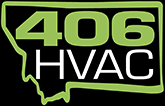Regular inspections are an essential part of your HVAC system’s upkeep and can help you get the most of your unit. In this blog, HVAC contractor 406 HVAC delves into the importance of regular HVAC inspections.

HVAC Inspections
It should be noted that HVAC inspections are different from the scheduled maintenance conducted by HVAC professionals. Inspections can be conducted at your own convenience, albeit during prescribed times, such as early to mid-spring, just before the summer season sets in.
Regular HVAC inspections will let you:
-
Keep an eye on your HVAC system’s operational condition.
-
Perform basic maintenance tasks on air filters and other user-serviceable parts.
-
Maintain IAQ (indoor air quality) and help reduce risks associated with indoor air pollution.
-
Call a heating and air conditioning repair professional as soon as possible, should the need arise.
The capacity to call for repairs as soon as possible is especially important. Minor HVAC problems cost less and don’t take as long to fix, as opposed to waiting until the next scheduled maintenance check or when the HVAC system breaks down. An HVAC system running at full efficiency can help you save on energy costs and make your home more comfortable during climatic extremes. It’s also less likely to break down during heavy usage.
Inspecting Your HVAC System
The first thing to remember about inspecting your own HVAC system is that you aren’t expected to perform repairs. However, if you find that your HVAC system needs some cleaning, then you need to take care of it. A few tools such as a dust brush or a clean paintbrush and a set of screwdrivers for removing grilles and front plates should be enough. You can also use a small handheld vacuum cleaner to remove accumulated dust.
Clean dust off the registers, then remove the filters and clean them. Dirty air filters can reduce HVAC system output and should be inspected and cleaned at least once a month during peak seasons. Put them back once dry. Inspect the ductwork for leaks. You can run your hand along parts of the ducts while the HVAC system is running, and you should be able to feel if it’s leaking heat or cold air.
Finally, test the thermostat by setting the output slightly higher than usual and see if the thermostat responds. If it doesn’t, perform basic troubleshooting as described in the thermostat care and maintenance guide.
When searching online for “HVAC contractors near me,” choose 406 HVAC. Give us a call at (406) 534-1239 or fill out our contact form to schedule an appointment.
